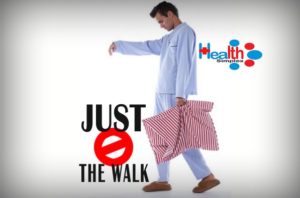
18 Aug SLEEP WALKING.
Sleepwalking, medically called somnabulism or noctabulism is a sleep or behavior disorder that occurs during sleep and results in walking or performing other complex behaviors while asleep. It is commoner in children (3 – 7 years) and more frequent in persons deprived of sleep.
 Sleepwalkers can perform activities such as sitting up in bed, walking to restroom, cooking, driving, or even homicide. It can be very hard to wake a Sleepwalker, when they do wake up can they can be very confused, leaving little
Sleepwalkers can perform activities such as sitting up in bed, walking to restroom, cooking, driving, or even homicide. It can be very hard to wake a Sleepwalker, when they do wake up can they can be very confused, leaving little or no memory of the incident as their consciousness has altered in a state in which it is harder to recall memories.
Sleep is categorized into Rapid Eye
Movement (REM) sleep and non – REM (NREM) sleep stage. Each night, People go through several cycles of NREM and REM sleep. NREM sleep is further divided into as follows:
Stage 1(a light sleep period), stage 2(a consolidated sleep period) , stage 3 and 4 (slow wave periods) which recedes again in a stage 3, 2, 1, and a REM period. In normal adults, a cycle will last about 1.5hours. Sleepwalking generally occurs during the first third of the night during the slow wave NREM sleep.
EPIDEMIOLOGY
The National sleep Foundation In US puts the prevalence of sleepwalking in the range of 1 – 15 % of the population. Episodes of sleepwalking are commoner in childhood, peaking at 4 – 8 years and decrease with age.
Sleepwalking is not usually a sign that something is emotionally or psychologically wrong with a child. The onset of Sleepwalking in adulthood is less common than in children. In many cases, adults might sleepwalk only after consuming alcohol or drugs. Nevertheless, Sleepwalking can be a symptom of some psychological disorder.
DIAGNOSIS
The only accurate test for Sleepwalking behavior is Polysomnography which monitors many body functions including Brain (EEG), Eye movement (EOG) , Skeletal muscle activity (EMG) and Heart rhythm(ECG) during sleep.
CAUSES
Precipitating factors to Sleepwalking are those factors which increase the slow wave sleep stage and include :
Sleep deprivation, excessive tiredness, fever. Others include Drugs like neuroleptics or hypnotics, alcohol.
Some experts have linked an immaturity in the central Nervous system as a possible cause. Medical conditions such as partial complex seizures have been implicated.
Sleepwalking may be inherited from one or both parents although environmental factors may influence it’s expression.
TREATMENT
Behavioral modifications plays a vital role and include :
Putting away dangerous items and locking doors and windows before sleep to reduce risks of harmful activity while Sleepwalking.
Good sleep hygiene and avoiding sleep deprivation.
Some drugs such as low dose benzodiazepines can come handy.
Credit: Dr. Nriagu Cordis




No Comments